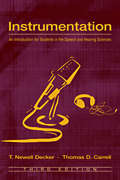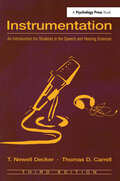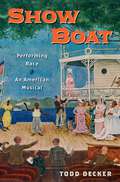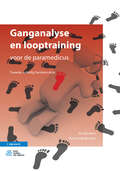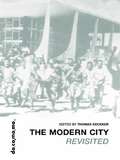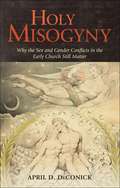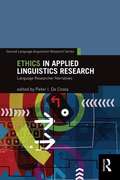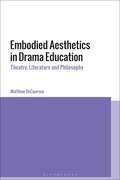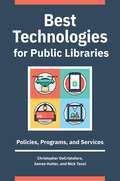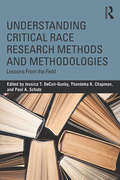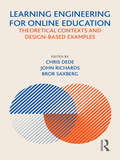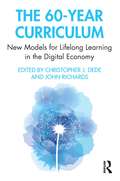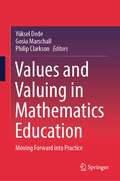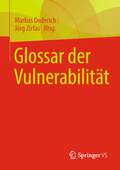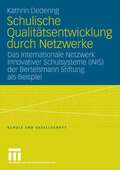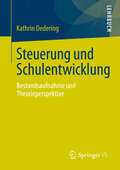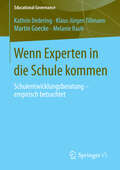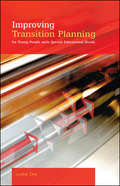- Table View
- List View
Instrumentation: An Introduction for Students in the Speech and Hearing Sciences
by T. Newell Decker Thomas D. CarrellWhile keeping the scope and essential thrust of the original book unchanged, this third edition has been updated to reflect the latest technology. For instance, important revisions have been made to a few chapters, while one chapter has been eliminated and replaced with a newer chapter dealing with recent developments in digital and consumer electronics that are relevant to laboratory instrumentation. The authors hope the readers of this text will be more confident with instrumentation and more willing to experiment with it, as well as be able to appreciate the possible ways that electronic instrumentation can be used in their work. The book was written with the undergraduate in speech and hearing sciences uppermost in mind. Instead of detailed information about individual pieces of instrumentation, a more basic and broad descriptive approach has been used. Throughout, examples have been provided regarding how certain pieces of equipment can be used in the clinic or laboratory. One or more step-by-step exercises are included at the end of certain chapters to help students obtain hands-on experience and equipment flowcharts help reinforce the exercise. Students who complete this book will have a basic understanding of the major pieces of instrumentation in the hearing and speech clinic/laboratory.
Instrumentation: An Introduction for Students in the Speech and Hearing Sciences
by T. Newell Decker Thomas D. CarrellWhile keeping the scope and essential thrust of the original book unchanged, this third edition has been updated to reflect the latest technology. For instance, important revisions have been made to a few chapters, while one chapter has been eliminated and replaced with a newer chapter dealing with recent developments in digital and consumer electronics that are relevant to laboratory instrumentation. The authors hope the readers of this text will be more confident with instrumentation and more willing to experiment with it, as well as be able to appreciate the possible ways that electronic instrumentation can be used in their work. The book was written with the undergraduate in speech and hearing sciences uppermost in mind. Instead of detailed information about individual pieces of instrumentation, a more basic and broad descriptive approach has been used. Throughout, examples have been provided regarding how certain pieces of equipment can be used in the clinic or laboratory. One or more step-by-step exercises are included at the end of certain chapters to help students obtain hands-on experience and equipment flowcharts help reinforce the exercise. Students who complete this book will have a basic understanding of the major pieces of instrumentation in the hearing and speech clinic/laboratory.
Show Boat: Performing Race in an American Musical (Broadway Legacies)
by Todd DeckerShow Boat: Performing Race in an American Musical tells the full story of the making and remaking of the most important musical in Broadway history. Drawing on exhaustive archival research and including much new information from early draft scripts and scores, this book reveals how Oscar Hammerstein II and Jerome Kern created Show Boat in the crucible of the Jazz Age to fit the talents of the show's original 1927 cast. After showing how major figures such as Paul Robeson and Helen Morgan defined the content of the show, the book goes on to detail how Show Boat was altered by later directors, choreographers, and performers up to the end of the twentieth century. All the major New York productions are covered, as are five important London productions and four Hollywood versions. Again and again, the story of Show Boat circles back to the power of performers to remake the show, winning appreciative audiences for over seven decades. Unlike most Broadway musicals, Show Boat put black and white performers side by side. This book is the first to take Show Boat's innovative interracial cast as the defining feature of the show. From its beginnings, Show Boat juxtaposed the talents of black and white performers and mixed the conventions of white-cast operetta and the black-cast musical. Bringing black and white onto the same stage -- revealing the mixed-race roots of musical comedy -- Show Boat stimulated creative artists and performers to renegotiate the color line as expressed in the American musical. This tremendous longevity allowed Show Boat to enter a creative dialogue with the full span of Broadway history. Show Boat's voyage through the twentieth century offers a vantage point on more than just the Broadway musical. It tells a complex tale of interracial encounter performed in popular music and dance on the national stage during a century of profound transformations.
Show Boat: Performing Race in an American Musical (Broadway Legacies)
by Todd DeckerShow Boat: Performing Race in an American Musical tells the full story of the making and remaking of the most important musical in Broadway history. Drawing on exhaustive archival research and including much new information from early draft scripts and scores, this book reveals how Oscar Hammerstein II and Jerome Kern created Show Boat in the crucible of the Jazz Age to fit the talents of the show's original 1927 cast. After showing how major figures such as Paul Robeson and Helen Morgan defined the content of the show, the book goes on to detail how Show Boat was altered by later directors, choreographers, and performers up to the end of the twentieth century. All the major New York productions are covered, as are five important London productions and four Hollywood versions. Again and again, the story of Show Boat circles back to the power of performers to remake the show, winning appreciative audiences for over seven decades. Unlike most Broadway musicals, Show Boat put black and white performers side by side. This book is the first to take Show Boat's innovative interracial cast as the defining feature of the show. From its beginnings, Show Boat juxtaposed the talents of black and white performers and mixed the conventions of white-cast operetta and the black-cast musical. Bringing black and white onto the same stage -- revealing the mixed-race roots of musical comedy -- Show Boat stimulated creative artists and performers to renegotiate the color line as expressed in the American musical. This tremendous longevity allowed Show Boat to enter a creative dialogue with the full span of Broadway history. Show Boat's voyage through the twentieth century offers a vantage point on more than just the Broadway musical. It tells a complex tale of interracial encounter performed in popular music and dance on the national stage during a century of profound transformations.
Ganganalyse en looptraining: voor de paramedicus
by Jos Deckers Dominiek BeckersDit boek behandelt op een gestructureerde wijze de ganganalyse als basis voor een therapeutische looptraining. Het bespreekt het normale loopbeeld en gaat vervolgens dieper in op specifieke loopafwijkingen. Veel somatische letsels en aandoeningen leiden tot een verstoring van het normale gaan of lopen. Fysiotherapeuten en paramedici worden dan ook dagelijks geconfronteerd met problemen op dit gebied. In Ganganalyse en looptraining komen zowel orthopedische als perifere en centrale neurologische aandoeningen aan bod. Daarnaast behandelt het loopafwijkingen die zijn veroorzaakt door aandoeningen aan heup, knie en voet, evenals het gebruik van orthopedische hulpmiddelen, zoals orthesen. Met behulp van een analyseformulier worden de problemen in de gang duidelijk en inzichtelijk. Op basis van de geanalyseerde problemen in het formulier kan de therapeut komen tot een duidelijke probleemstelling en daaruit volgend een behandelplan. Om te komen tot een therapeutische oplossing worden de veroorzakers van gangafwijkingen uitgebreid beschreven. Deze tweede, volledig herziene druk beschrijft niet alleen de meest frequente loopproblemen, maar ook de oorzaken en de bijbehorende trainingsindicaties. De praktische en didactische waarde van het boek wordt nog verhoogd door de bijbehorende website vol boeiend digitaal lesmateriaal met uitgebreide casuïstiek. Ganganalyse en looptraining richt zich in het bijzonder op eerste- en tweedelijnsfysiotherapeuten, fysiotherapeuten in opleiding en geriatriefysiotherapeuten. Daarnaast is dit boek relevant voor revalidatieartsen, oefentherapeuten, ergotherapeuten en orthopedisch instrumentmakers.
Modern City Revisited
by Thomas DeckkerThe supposed rationality of the urban planning of the Modern Movement encompassed a variety of attitudes towards history, technology and culture, from the vision of Berlin as an American metropolis, through the dispute between the urbanists and disurbanists in the Soviet Union to the technocratic and austere vision of Le Corbusier. After the Second World War, architects attempted to reconcile these utopian visions to the practical problems of constructing - or reconstructing - urban environments, from Piero Bottoni at the Quartiere Trienale 8 in Milan in 1951 to Lucio Costa at Bras'lia in 1957. In the 1970s, the collapse of Modernism brought about universial condemnation of Modern urbanism; urban planning,and rationality itself, were thrown into doubt. However, such a wholesale condemnation hides the complex realities underlying these Modern cities. The contributors define some of the theoretical foundations of Modern urban planning, and reassess the successes and the failures of the built results. The book ends with contrasting views of the inheritance of Modern urbanism in the United States and the Netherlands.
Modern City Revisited
by Thomas DeckkerThe supposed rationality of the urban planning of the Modern Movement encompassed a variety of attitudes towards history, technology and culture, from the vision of Berlin as an American metropolis, through the dispute between the urbanists and disurbanists in the Soviet Union to the technocratic and austere vision of Le Corbusier. After the Second World War, architects attempted to reconcile these utopian visions to the practical problems of constructing - or reconstructing - urban environments, from Piero Bottoni at the Quartiere Trienale 8 in Milan in 1951 to Lucio Costa at Bras'lia in 1957. In the 1970s, the collapse of Modernism brought about universial condemnation of Modern urbanism; urban planning,and rationality itself, were thrown into doubt. However, such a wholesale condemnation hides the complex realities underlying these Modern cities. The contributors define some of the theoretical foundations of Modern urban planning, and reassess the successes and the failures of the built results. The book ends with contrasting views of the inheritance of Modern urbanism in the United States and the Netherlands.
Holy Misogyny: Why the Sex and Gender Conflicts in the Early Church Still Matter
by April D. DeConickIn Holy Misogyny, bible scholar April DeConick wants real answers to the questions that are rarely whispered from the pulpits of the contemporary Christian churches. Why is God male? Why are women associated with sin? Why can't women be priests? Drawing on her extensive knowledge of the early Christian literature, she seeks to understand the conflicts over sex and gender in the early church-what they were and what was at stake. She explains how these ancient conflicts have shaped contemporary Christianity and its promotion of male exclusivity and superiority in terms of God, church leadership, and the bed. DeConick's detective work uncovers old aspects of Christianity before later doctrines and dogmas were imposed upon the churches, and the earlier teachings about the female were distorted. Holy Misogyny shows how the female was systematically erased from the Christian tradition, and why. She concludes that the distortion and erasure of the female is the result of ancient misogyny made divine writ, a holy misogyny that remains with us today.
Holy Misogyny: Why the Sex and Gender Conflicts in the Early Church Still Matter
by April D. DeConickIn Holy Misogyny, bible scholar April DeConick wants real answers to the questions that are rarely whispered from the pulpits of the contemporary Christian churches. Why is God male? Why are women associated with sin? Why can't women be priests? Drawing on her extensive knowledge of the early Christian literature, she seeks to understand the conflicts over sex and gender in the early church-what they were and what was at stake. She explains how these ancient conflicts have shaped contemporary Christianity and its promotion of male exclusivity and superiority in terms of God, church leadership, and the bed. DeConick's detective work uncovers old aspects of Christianity before later doctrines and dogmas were imposed upon the churches, and the earlier teachings about the female were distorted. Holy Misogyny shows how the female was systematically erased from the Christian tradition, and why. She concludes that the distortion and erasure of the female is the result of ancient misogyny made divine writ, a holy misogyny that remains with us today.
Ethics In Applied Linguistics Research (PDF): Language Researcher Narratives
by Peter DeCostaEthics in Applied Linguistics Research explores how ethical issues are negotiated in different areas of language research, illustrating for graduate students in applied linguistics the ethical dilemmas they might encounter in the research methodology classroom and how they might be addressed. This volume serves to demystify the complex ethical decision-making process by its accounts of renowned researchers’ ethical practices as they transpired on the ground and how they negotiated externally imposed research codes. The collection investigates and records the research practices of prominent international applied linguists from a wide variety of subdisciplines, including discourse analysis, educational linguistics, heritage and minority education, language planning and policy, language and technology, literacy, second language acquisition, second and foreign language pedagogy, and sociolinguistics. By problematizing research practices that draw on a range of methodologies, Ethics in Applied Linguistics Research puts front and center the urgency to prepare the next generation of applied linguists with the tools and knowledge necessary to conduct ethical research in an increasingly globalized and networked world.
Embodied Aesthetics in Drama Education: Theatre, Literature and Philosophy
by Matthew DeCourseyIf it is a good thing to use drama for education, there must be something specific about drama that makes it good for the purpose. It has power of some kind: it makes things meaningful that would otherwise be meaningless, or things memorable that would otherwise be forgettable. Or perhaps it enables independent thought in an area that would otherwise become mere rote learning. Many practitioners believe that drama has the power to develop learner autonomy, or even to give learners power over their lives. In the last twenty years, a widespread view has developed that this 'something' that creates the benefit of drama is 'aesthetics'. There are many views of aesthetics, but what unites them is the special significance that art has for our lives. This book is about the relation between aesthetics and education in the use of drama. Within it, philosophy appears as the essential connecting discipline between the practice of arts-based education and our advancing knowledge of the interrelations of cognition, emotion, and embodiment. Matthew DeCoursey argues that the power of dramatic art is to be found in its bodily, emotional nature. Drawing on recent work in the aesthetics of theatre, he shows that much of the power of theatre can be attributed to a specific range of ideas and techniques, notably including double meaning-making, aesthetic focus and dramatic tension. Finally, the author relates different forms of drama education to different educational results, holding that the conventional improvised forms are neither superior nor inferior to scripted theatre, but merely serve different purposes. Among those educational results discussed are the emancipation sought both by Rancière and by many practitioners of applied theatre, but also curricular areas, including language education.
Embodied Aesthetics in Drama Education: Theatre, Literature and Philosophy
by Matthew DeCourseyIf it is a good thing to use drama for education, there must be something specific about drama that makes it good for the purpose. It has power of some kind: it makes things meaningful that would otherwise be meaningless, or things memorable that would otherwise be forgettable. Or perhaps it enables independent thought in an area that would otherwise become mere rote learning. Many practitioners believe that drama has the power to develop learner autonomy, or even to give learners power over their lives. In the last twenty years, a widespread view has developed that this 'something' that creates the benefit of drama is 'aesthetics'. There are many views of aesthetics, but what unites them is the special significance that art has for our lives. This book is about the relation between aesthetics and education in the use of drama. Within it, philosophy appears as the essential connecting discipline between the practice of arts-based education and our advancing knowledge of the interrelations of cognition, emotion, and embodiment. Matthew DeCoursey argues that the power of dramatic art is to be found in its bodily, emotional nature. Drawing on recent work in the aesthetics of theatre, he shows that much of the power of theatre can be attributed to a specific range of ideas and techniques, notably including double meaning-making, aesthetic focus and dramatic tension. Finally, the author relates different forms of drama education to different educational results, holding that the conventional improvised forms are neither superior nor inferior to scripted theatre, but merely serve different purposes. Among those educational results discussed are the emancipation sought both by Rancière and by many practitioners of applied theatre, but also curricular areas, including language education.
Best Technologies for Public Libraries: Policies, Programs, and Services
by Christopher DeCristofaro James Hutter Nick TanziEmerging technologies can intimidate with their cost and uncertainty—this book provides flexible options for adopting the most popular ones.Introducing new technologies to your library can be a daunting process; they can be costly, they may be unfamiliar to many staff members, and their success is far from assured. To address these concerns, Best Technologies for Public Libraries accommodates budgets large and small, providing options for both the ambitious and the cost-conscious. Authors Christopher DeCristofaro, James Hutter, and Nick Tanzi provide a resource for staff looking to incorporate a number of emerging technologies into their library and makerspaces. Each chapter explores a new technology, including 3D printing, drones, augmented reality, and virtual reality, covering how the technologies work, the selection process, training, sample programming, best practices, and relevant policy. By describing a variety of program and service ideas across age groups, the book gives readers the ability to first evaluate them within the context of their own organization before incorporating ideas à la carte. This approach helps readers to adopt these new technologies and create policies with uses already in mind.
Best Technologies for Public Libraries: Policies, Programs, and Services
by Christopher DeCristofaro James Hutter Nick TanziEmerging technologies can intimidate with their cost and uncertainty—this book provides flexible options for adopting the most popular ones.Introducing new technologies to your library can be a daunting process; they can be costly, they may be unfamiliar to many staff members, and their success is far from assured. To address these concerns, Best Technologies for Public Libraries accommodates budgets large and small, providing options for both the ambitious and the cost-conscious. Authors Christopher DeCristofaro, James Hutter, and Nick Tanzi provide a resource for staff looking to incorporate a number of emerging technologies into their library and makerspaces. Each chapter explores a new technology, including 3D printing, drones, augmented reality, and virtual reality, covering how the technologies work, the selection process, training, sample programming, best practices, and relevant policy. By describing a variety of program and service ideas across age groups, the book gives readers the ability to first evaluate them within the context of their own organization before incorporating ideas à la carte. This approach helps readers to adopt these new technologies and create policies with uses already in mind.
Understanding Critical Race Research Methods and Methodologies: Lessons from the Field
by Jessica T. DeCuir-Gunby Thandeka K. Chapman Paul A. SchutzDespite the growing urgency for Critical Race Theory (CRT) in the field of education, the "how" of this theoretical framework can often be overlooked. This exciting edited collection presents different methods and methodologies, which are used by education researchers to investigate critical issues of racial justice in education from a CRT perspective. Featuring scholars from a range of disciplines, the chapters showcase how various researchers synthesize different methods—including qualitative, quantitative and mixed methods, and historical and archival research—with CRT to explore issues of equity and access in the field of education. Scholars discuss their current research approaches using CRT and present new models of conducting research within a CRT framework, offering a valuable contribution to ongoing methodological debates. Researchers across different levels of expertise will find the articulations of CRT and methods insightful and compelling.
Learning Engineering for Online Education: Theoretical Contexts and Design-Based Examples
by Chris Dede John Richards Bror SaxbergLearning Engineering for Online Education is a comprehensive overview of the emerging field of learning engineering, a form of educational optimization driven by analytics, design-based research, and fast-paced, large-scale experimentation. Chapters written by instructional design and distance learning innovators explore the theoretical context of learning engineering and provide design-based examples from top educational institutions. Concluding with an agenda for future research, this volume is essential for those interested in using data and high-quality outcome evidence to improve student engagement, instructional efficacy, and results in online and blended settings.
Learning Engineering for Online Education: Theoretical Contexts and Design-Based Examples
by Chris Dede John Richards Bror SaxbergLearning Engineering for Online Education is a comprehensive overview of the emerging field of learning engineering, a form of educational optimization driven by analytics, design-based research, and fast-paced, large-scale experimentation. Chapters written by instructional design and distance learning innovators explore the theoretical context of learning engineering and provide design-based examples from top educational institutions. Concluding with an agenda for future research, this volume is essential for those interested in using data and high-quality outcome evidence to improve student engagement, instructional efficacy, and results in online and blended settings.
The 60-Year Curriculum: New Models for Lifelong Learning in the Digital Economy
by Christopher J. DedeThe 60-Year Curriculum explores models and strategies for lifelong learning in an era of profound economic disruption and reinvention. Over the next half-century, globalization, regional threats to sustainability, climate change, and technologies such as artificial intelligence and data mining will transform our education and workforce sectors. In turn, higher education must shift to offer every student life-wide opportunities for the continuous upskilling they will need to achieve decades of worthwhile employability. This cutting-edge book describes the evolution of new models—covering computer science, inclusive design, critical thinking, civics, and more—by which universities can increase learners’ trajectories across multiple careers from mid-adolescence to retirement. Stakeholders in workforce development, curriculum and instructional design, lifelong learning, and higher and continuing education will find a unique synthesis offering valuable insights and actionable next steps.
The 60-Year Curriculum: New Models for Lifelong Learning in the Digital Economy
by Christopher J. Dede John RichardsThe 60-Year Curriculum explores models and strategies for lifelong learning in an era of profound economic disruption and reinvention. Over the next half-century, globalization, regional threats to sustainability, climate change, and technologies such as artificial intelligence and data mining will transform our education and workforce sectors. In turn, higher education must shift to offer every student life-wide opportunities for the continuous upskilling they will need to achieve decades of worthwhile employability. This cutting-edge book describes the evolution of new models—covering computer science, inclusive design, critical thinking, civics, and more—by which universities can increase learners’ trajectories across multiple careers from mid-adolescence to retirement. Stakeholders in workforce development, curriculum and instructional design, lifelong learning, and higher and continuing education will find a unique synthesis offering valuable insights and actionable next steps.
Values and Valuing in Mathematics Education: Moving Forward into Practice
by Yüksel Dede Gosia Marschall Philip ClarksonThis book is a follow-up to 'Values and Valuing in Mathematics Education: Scanning and Scoping the Territory' (2019, Springer). This book adds a critical emphasis on practice and fosters thinking concerning positive mathematical well-being, engagement, teacher noticing, and values alignment among a range of critical notions that intersect with values and valuing. Values and valuing play a key role in many aspects of education, such as assessment, planning, classroom interactions, choosing tasks, and general well-being. What one values and finds important in the learning and teaching of mathematics operates within the intersection of all social, cognitive, and affective aspects of school pedagogy, making values a significant holistic factor in education. The chapters explore potential teaching strategies that enhance the understanding of the central place of values in mathematics itself as a subject, as well as how values impact how mathematics is used withinsociety. This book includes examples of strategies for facilitating students’ meaningful engagement with, and conscious learning of, values when engaging in mathematical thinking and doing.
Glossar der Vulnerabilität
by Markus Dederich Jörg ZirfasDieses Glossar unternimmt den ersten Versuch, das semantische Feld des Begriffs ‚Vulnerabilität‘ einzugrenzen und die mit ihm verbundenen heterogenen Phänomene in ihren Überlappungen und Wechselwirkungen kenntlich zu machen. Das Glossar ist dabei an einem anthropologischen, phänomenologischen und pragmatischen Verständnis von Vulnerabilität orientiert. Dargestellt und analysiert werden Phänomene, Ursachen und Folgen unterschiedlicher Formen von Vulnerabilität aus unterschiedlichen disziplinären Zugängen. Neben der Vielschichtigkeit und Komplexität und neben den problematischen und positiven Momenten von Vulnerabilität kommen auch pädagogische Möglichkeiten zur Sprache, diese zu bewältigen und zu gestalten.
Schulische Qualitätsentwicklung durch Netzwerke: Das Internationale Netzwerk Innovativer Schulsysteme (INIS) der Bertelsmann Stiftung als Beispiel (Schule und Gesellschaft)
by Kathrin DederingSchulnetzwerke tragen auf ganz vielfältige Weise dazu bei, dass auf der Ebene von Einzelschulen Schulentwicklungsprozesse in Gang gesetzt werden, die inhaltlich, methodisch und organisatorisch zu einer Qualitätsverbesserung führen. Ihnen kommt die Funktion eines Impulsgebers und einer Reflexionshilfe zu. Sie nutzen den Schulen und führen zu einem Mehrwert. Kathrin Dedering zeigt, dass die Teilnahme von Einzelschulen an Schulnetzwerken nicht per se eine weit reichende oder umfängliche Einflusskraft auf deren Entwicklungsarbeit ausübt. Wie erfolgreich die Teilnahme am Schulnetzwerk ist, wird vornehmlich von an den Schulen bereits bestehenden Merkmalen der Organisationskultur bestimmt.
Steuerung und Schulentwicklung: Bestandsaufnahme und Theorieperspektive
by Kathrin Dedering'Steuerung im Bildungssystem' ist zu einem Schlüsselbegriff geworden, der in dieser Einführung in seiner Relation zur Schulentwicklung dargestellt und erklärt wird. Beide Kategorien 'Steuerung' und 'Schulentwicklung' werden nachvollziehbar konkretisiert und in ihrem Verhältnis zueinander beschrieben. Ausgehend von der Frage, welchen Stellenwert der Aspekt der Steuerung des Bildungssystems bzw. der Einzelschule in einer Theorie der Schulentwicklung einnimmt und welche Relevanz Steuerungsinstrumente für den theoretischen Diskurs besitzen, wird 'Steuerung' als Kategorie verortet. Nach einer theoretischen wie empirischen Analyse ausgewählter Steuerungsinstrumente wird gefragt, welchen Beitrag im diese zu einer Theorie der Schulentwicklung leisten können - mit dem Ergebnis, dass ein eher unzulänglicher Steuerungsbezug in Entwürfen komplexer Schulentwicklungstheorien und ein nur vermittelter schulentwicklungstheoretischer Bezug im Ansatz der Educational Governance zu finden ist.
Wenn Experten in die Schule kommen: Schulentwicklungsberatung - empirisch betrachtet (Educational Governance #23)
by Kathrin Dedering Klaus-Jürgen Tillmann Martin Goecke Melanie RauhDas Buch befasst sich mit der Beratung von Schulen bei ihrer Entwicklungsarbeit durch externe Experten: Was bewirken Unternehmensberater, was Pädagogische Berater, wenn sie in Schulen aktiv werden? Drei theoretische Zugänge – die Beratungstheorie, die Schulentwicklungstheorie und das Konzept von Educational Governance – bilden den Rahmen. Präsentiert werden Ergebnisse einer empirischen Untersuchung, die erstmals Erkenntnisse zur externen Schulentwicklungsberatung in Deutschland zur Verfügung stellt. Das DFG-geförderte Forschungsprojekt liefert auf der Basis von Befragungs- und Fallstudiendaten umfassende Informationen zu Rahmenbedingungen, zur Gestaltung, zum Ablauf und zu den Effekten der externen Schulentwicklungsberatung.
Improving Transition Planning (UK Higher Education OUP Humanities & Social Sciences Education OUP)
by Lesley DeeTransition planning for young people with special educational needs is a crucial but often overlooked element of social inclusion. While there is now considerable official guidance on how to manage the school leaving process for young people with learning difficulties and/or disabilities, little is known about how to make effective transitions happen in practice. This book supports the transition experiences of young people with a range of special educational needs. The book:Provides insights into the experiences and perspectives of young people, their parents or carers and the professionals who support them during the transition periodExplores influences on the decision-making processes and the involvement of young people and their parents or carers Suggests practical ways in which young people and their families and carers can be supported during the transition to adulthood.This is essential reading for Education students, teachers, headteachers, careers guidance and pastoral care personnel, parents or carers and educational psychologists.
